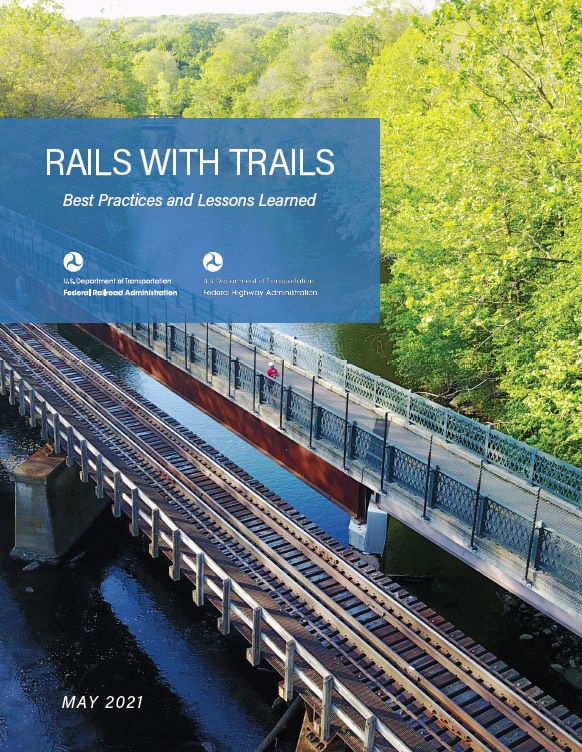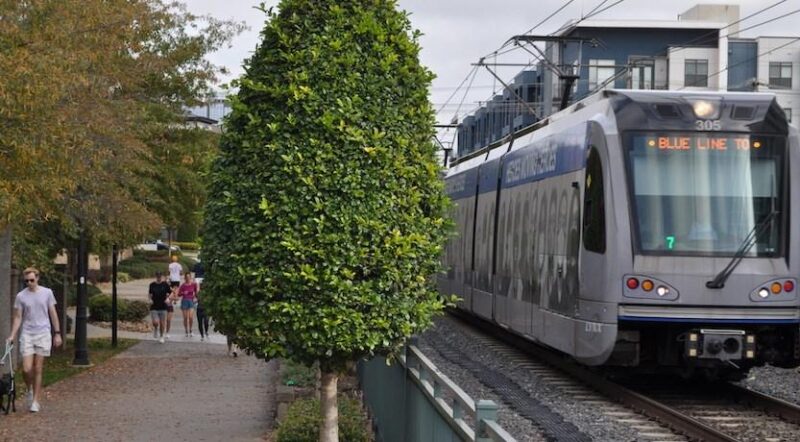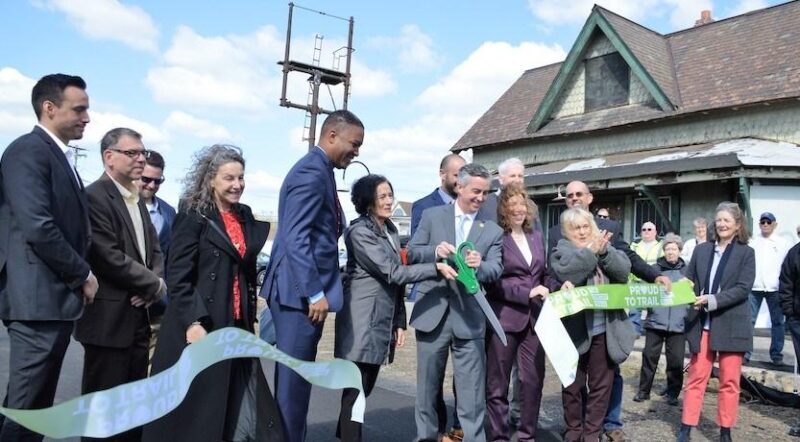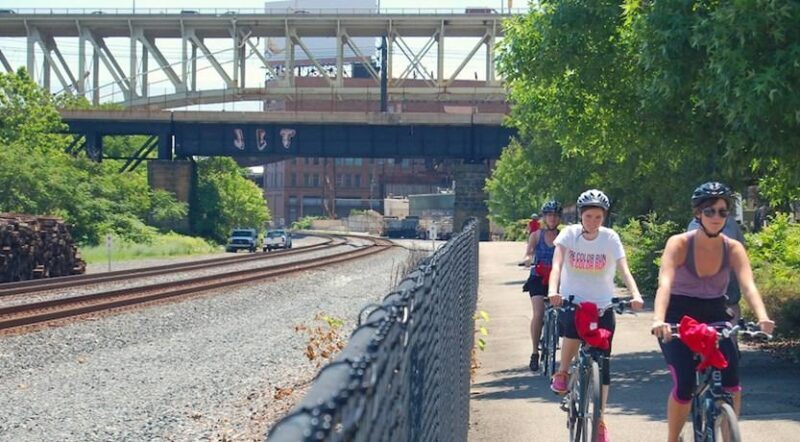Rail-With-Trail
Charlotte Trolley Trail, NC | Photo courtesy Nancy Pierce, Secretary for North Carolina Rail-Trails
Many people are familiar with the concept of rail-trails, which are multi-use trails developed on former railroad corridors. With the increasing popularity of rail-trails across the country, communities are looking for other innovative ways of securing land for safe, popular and effective trail development. An emerging answer is rails-with-trails, which are trails adjacent to or within an active railroad corridor. The rail-with-trail concept provides even more opportunities for the creation of trail systems that enhance local transportation systems, offering safe and attractive community connections.
Rails-with-trails can also provide a solution for rail companies and local governments concerned about safety risks posed by those who illegally cross rail lines. By providing a safe, attractive alternative for cyclists and pedestrians, often with fencing between the pathway and the railway, rails-with-trails can eliminate the previous incentive to use the tracks as a shortcut.
As of 2021, there are more than 399 rails-with-trails in the United States, with the length located along active railroad corridors totaling more than 1025 miles—and more are being built each year.

Rails-with-Trails: Best Practices and Lessons Learned released by the U.S. Department of Transportation (USDOT) in May 2021 is the latest, most comprehensive resource on rails-with-trails. This study documents how the state of the practice, perspectives, and context for rails-with-trails has evolved since USDOT’s first study on the topic was published in 2002.
RTC contributed to this study by conducting interviews with, and providing data from, more than 100 trail managers across the country, building on RTC’s own body of rail-with-trail research.* Several sources referenced in the study are included in the list below. RTC’s Trailblog summarizes key findings from the report.
- State laws and statutes relating to rails-with-trails (footnote 55)
- Example rail-with-trail easement agreement (footnote 38)
- Example rail-with-trail license agreement (footnote 39)
- Connecting Chattanooga Neighborhoods by Rail-Trail: An Examination of Railroad Corridors (footnote 41)
- Collection of sample rail-with-trail acquisition agreements (footnote 44 and 47)
- State Recreational Use Statutes (footnote 55)
* While USDOT’s 2021 report presents best practices and lessons learned from various stakeholders, the report does not constitute a standard, specification, regulation, or endorsement of rails-with-trails by USDOT. RTC’s America’s Rails-with-Trails (2013) continues to act as a more advocacy-focused resource and includes in-depth case studies that describe rail-with-trail development process in various scenarios.
Reports and Related Resources
The four most comprehensive resources on rails-with-trails were developed to address common concerns and highlight best practices used in this unique type of trail development. The reports include safety statistics, design guidelines, recommendations for acquisition methods and liability protection, sample legal agreements and case studies. Use these documents to learn more about successful rails-with-trails and to determine the best strategies for negotiating with the railroad or other managing agency:
- Rails-with-Trails: Best Practices and Lessons Learned. U.S. Department of Transportation, 2021.
- America’s Rails-with-Trails: A Resource for Planners, Agencies and Advocates on Trails Along Active Railroad Corridors. Rails-to-Trails Conservancy, 2013
- Rails-with-Trails: Lessons Learned. U.S. Department of Transportation, 2002.
- Rails-with-Trails: Design, Management, and Operating Characteristics of 61 Trails Along Active Rail Lines. Rails-to-Trails Conservancy, 2000.
Other related resources include:
- A list of known rail-with-trails
- Examples of easements and lease agreements
- A list of Recreational Use Statutes
Benefits
Rail-trails are an excellent repurposing of former railroad corridors, often transforming once-derelict properties into vibrant community assets. Rails-with-trails offer the same health, transportation and environmental benefits by utilizing existing resources when there may be limited appropriate space for multi-use trails. Rails-with-trails enhance local transportation networks by providing non-motorized connections that are sometimes preferable to on-road bike lanes or sidewalks located on congested, dangerous roadways.
Rails-with-trails can benefit railroads, too. In some instances, the trail manager purchases a use easement or license from the railroad, providing financial compensation. A fully developed trail may also provide the railroad with improved access for maintenance vehicles.
Concerns
Safety is probably the biggest concern when considering a rail-with-trail project. Both railroads and potential trail managers may be apprehensive about placing a public trail close to an active railroad track, fearing an increased risk of accidents along the corridor. Fortunately, various levels of protection are available to railroads and trail managers. State Recreational Use Statutes (RUSs) provide landowners with special protection from liability. The State of Maine amended its Recreational Use Statute to offer the same degree of protection to owners of railroad and utility corridors. Some railroads may require trail managers to accept full liability—also called indemnification—when negotiating a rail-with-trail agreement. For a more comprehensive analysis of the liability and risk management issues associated with rails-with-trails, see Section III of America’s Rails-with-Trails (2013) and Section V of Rails-with-Trails: Best Practices and Lessons Learned (2021).
Despite common concerns and considerations, many successful rails-with-trails across the country stand as a testament to the ability of trains and trails to coexist. For a list of several rails-with-trails and associated information such as characteristics of train traffic, safe design and exposure to risk and liability, see the Rail-with-Trail Survey Findings in Section IV of America’s Rails-with-Trails. Section VI of Rails-with-Trails: Best Practices and Lessons Learned summarizes how effective design practices can address common concerns of rails-with-trails.
Large Class I railroads may be hesitant to enter into rail-with-trail agreements because trail development may mean a loss of right-of-way width and a perceived potential for lawsuits. However, smaller railroad operations may be more willing to negotiate an agreement, especially transit or tourist trains that are typically owned and managed by governmental entities whose mission it is to serve the public interest. The Rail-with-Trail Case Studies found in Section V of America’s Rails-with-Trails include specific information on three successful trails alongside excursion railroads.
Environmental contaminants may also be a concern and should be addressed when developing a feasibility study (see “Determining Feasibility and Developing a Plan” in Section IV of Rails-with-Trails: Best Practices and Lessons Learned).
Despite these common concerns, more rails-with-trails are being built across the U.S., presenting a unique solution to the challenge of keeping people safe while also making optimal use of railroad corridors to accommodate the mobility needs of all.
Resources
‣ Webinar – Trains & Trails Together: Trends, Challenges & Effective Practices for Rail-with-Trail Development
‣ Report – Rails-with-Trails: Best Practices and Lessons Learned (2021)
‣ Report – America’s Rails-with-Trails (2013)
‣ Report – Rails-with-Trails: Lessons Learned (2002)
‣ Report – Connecting Chattanooga Neighborhoods by Rail Trail: An Examination of Railroad Corridors
‣ Fact Sheet – Rail-with-Trail List
‣ Fact Sheet – Recreational Use Statutes
‣ Fact Sheet – State-by-State Matrix of Applicable Laws and Statutes relating to Rails-with-Trails
‣ Contract – Multi-purpose Recreational Trail Easement
‣ Contract – General License for Multiple Use Trail
Rail-With-Trail Stories
View More BlogsTrailNation Collaborative
TrailNation™ Collaborative is a nationwide peer learning community from Rails to Trails Conservancy that brings together advocates, leaders and professionals from across disciplines to establish and accelerate trail networks across America. The collaborative provides proven tools, methods and resources, combined with RTC’s expertise and network of partners across the country, to accelerate the development of connected trail systems. When trails are connected across regions and states, trail networks have a proven transformative impact—they are essential infrastructure that creates thriving, healthier communities.


